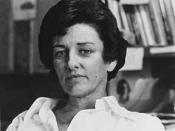With many variations of fantasies, "Happily ever after" is reoccurring in every fairy tale. "Cinderella" by Anne Sexton is a different variation of the classic tale. The author sets up her version of Cinderella with four anecdotes sharing how others can go from poverty to riches or gritty reality to fantasy. Sexton changes her happily ever after ending by satirizing the message the story gives. By doing so, Sexton would like the reader to know the difference between a fairy tale and reality. Anne Sexton deconstructs the ending of her retold fairy tale by using sarcasm to change the reader's expectations of the story and myth.
Setting up the poem with little anecdotes of unexpected reality, Sexton's sarcastic tone foreshadows the outcome of the poem. In the first anecdote, Sexton writes, "You always read about it: the plumber with twelve children who wins the Irish sweepstakes. From toilets to riches.
That story" (S1). Sexton uses a sarcastic tone by implying the situational irony in each story. The reader may find it hard to believe the story because each anecdote is so far fetched. The fantasy is brought back into gritty reality, however, the luck the man has to be in a poverty stricken situation to win the Irish sweepstakes. Sexton brings fantasy into the fairy tale so the readers can pick up on it and relate the new fantasy with Cinderella's tale. Sexton implies that the happily ever after story happens by pure chance and luck, not experienced by everyone.
Sexton's uses sarcasm in the refrain to influence the reader's predictions of the fairy tale by using the previous knowledge of the story Cinderella. "That Story" (L 5,10,21,109) is used as the refrain in the poem. "That story" is a clue for the reader to rethink the previous told stories...


